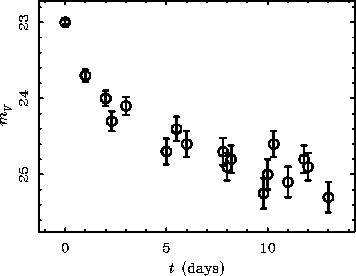Consider the epoch of radiation domination where the energy density is dominated by photons with ρ = aT4 (where a is the radiation constant and T is their temperature) and the equation of state is P = ρ/3.
Justify any assumptions you need to make.
- a) How is the scale factor related to T?
- b) How does the scale factor R(t) vary with time during this epoch?
- c) Write the equivalent expression for T(t).
Note: depending on how you approach the problem, it may be easier to reverse the order of (b) and (c). - d) Verify the consistency of the Friedmann equation and the expression for the second time derivative of R.
- a) Assume the early universe is filled with stuff ρ which obeys
the equation of state p = -ρ.
What is ρ(t)?
[Hint: use only the equation of state and conservation of mass-energy.] - b) Derive R(t).
Write H in terms of ρ and Λ. (Note: do not equate these two.)
What do you have to assume to do this? How might you justify this assumption? - c) Why does Inflation predict Ωk = 0?
(or equivalently, Ωm + ΩΛ = 1.)
- a) Write the Friedmann equation in terms of Ωs and the redshift z and its time derivative. Ignore the curvature and cosmological constant terms to obtain an expression for t(z), the age of the universe at redshift z. [This is sometimes called the Einsten-de Sitter limit.]
- b) The leading term of the expression from (a)
involving H0 and Ωm0
can be thought of as the "age" of the universe: t(z=0).
Is this a valid approximation, given the assumption made in (a)?
If not, at what redshift might it become valid?
[Hint: consider curvature and Λ terms as separate cases.] - c) It is fairly straightforward to age-date young stellar populations.
Suppose a galaxy observed at z=3 has spectral characteristics which indicate it has an age of 2 Gyr. What age does this imply for the universe now?
Professor Fink returns excited from an observing run because he has discovered a nova in a galaxy in the Virgo cluster, a key step in the distance scale. He knows that novae can be used as standard candles since they obey a luminosity--fade-time relation
MVpeak = -10.7 + 2.3 log(t2)
where t2 is the time in days that it takes for a nova to fade 2 magnitudes from its peak. (That's a base ten logarithm, as is conventional in astronomy.) Professor Fink hands you the data in the graph, and asks you to determine The Answer.
- a) What is the fade time t2? (Eyeball it.)
- b) What is the distance to Virgo from this?
- c) Supposing that Virgo has a recession velocity of 1400 km/s, what is H0?
- d) Fink assumes there is no extinction. How does the distance change if there is a little extinction, AV = 0.3? How does H0 change?
- e) Assume for the moment that AV = 0. What is the uncertainty in the distance determination?
- f) Not all novae are the same; there is some intrinsic dispersion in the luminosity--fade-time relation, about 0.5 mag. Galactic extinction maps suggest that the extinction is AV = 0.3 +/- 0.02. What now is the distance and its uncertainty? and H0?
(Keep in mind that the modern goal is to measure H0 to better than 10%.)
 Light curve of nova in the Virgo cluster.
Light curve of nova in the Virgo cluster.
Use the data of Verheijen 2001, ApJ, 563, 694 to determine the distance to the UMa cluster of galaxies using the I-band and K-band calibration of the HST Key Project (Sakai et al. 2000, ApJ, 529, 698). Be sure to include a plot of the data with calibration lines overlaid.
Assuming the recession velocity of the Ursa Major cluster is 1088 km/s, what Hubble constant(s) do you find? How does this compare to the value given by Sakai et al.?
* Note that Verheijen gives absolute magnitudes for a presumed distance of 15.5 Mpc. Also note that ascii versions of the tables, convenient for plotting, can be downloaded from the journal website.
** For the K'-band data, use the H-band calibrations assuming H-K = 0.25.